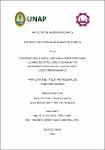| dc.contributor.advisor | García Pérez, Víctor | |
| dc.contributor.advisor | Salas Barrera, Fernando Javier | |
| dc.contributor.author | Chong Hidalgo, Pablo César | |
| dc.contributor.author | Ferreyra Tenazoa, Juan Sebastián | |
| dc.date.accessioned | 2023-08-08T15:54:08Z | |
| dc.date.available | 2023-08-08T15:54:08Z | |
| dc.date.issued | 2023 | |
| dc.identifier.uri | https://hdl.handle.net/20.500.12737/9250 | |
| dc.description.abstract | The target the general of the present thesis was: constructing, installing and implementing with a programmable logical control (PLC), to a prototype for filling of large bottles with water. Coming true ad hoc a revision detailed on the languages more used (ladder and FDB) in the programming of a PLC. Straightaway, came true the diagram ladder and the simulation of the filling of large bottles with water took effect, this in turn allowed determining that the quantity of physical receipts and expenditures that were used in the PLC are: three entrances (I1, I2, and I3) and three physical exits (Q1, Q2 and Q3). At last, came true the performance testings of said prototype, the ones that it was used in three (3) sets of large bottles, with the following nominal volumes: five of 3.8 L, two of 4.5 L and three of 20 L; findings of fact in each case the following times filling: 8.1 s, 9.5 s and 42.4 s, respectively. For the ten used large bottles, it has been determined that the difference trough and peak between the nominal volume and the observed volume are: 0.342 % and 2.000 %, respectively, which did not exceed of the 2 % regarding the nominal volume, being proved this way that the mentioned prototype works of efficient way. Then, it can be said that the present investigation is somewhat diligent, with quantitative focus and i design correlational. In this way the present work of thesis is concluded, coming true with every one of the realistic brand-name drugs and the general objective lens. | en_US |
| dc.description.abstract | El objetivo general de la presente tesis fue: construir, instalar e implementar con un controlador lógico programable (PLC), a un prototipo para llenado de botellones con agua, realizándose para esto una revisión detallada sobre los lenguajes más utilizados (ladder y BDF) en la programación de un PLC. Seguidamente, se realizó el diagrama ladder y se efectuó la simulación del llenado de botellones con agua; esto a su vez permitió determinar que la cantidad de entradas y salidas físicas que se utilizaron en el PLC son: tres entradas (I1, I2, e I3) y tres salidas físicas (Q1, Q2 y Q3). Finalmente, se realizaron las pruebas de funcionamiento de dicho prototipo, en las cuales se utilizó tres (3) conjuntos de botellones, con los siguientes volúmenes nominales: cinco (5) de 3.8 L, dos (2) de 4.5 L y tres (3) de 20 L; resultando en cada caso los siguientes tiempos de llenado: 8.1 s, 9.5 s y 42.4 s, respectivamente. Para los diez botellones utilizados, se ha determinado que la diferencia mínima y máxima entre el volumen nominal y el volumen observado son: 0.342 % y 2.000 %, respectivamente, lo cual no excedió del 2 % con respecto al volumen nominal, comprobándose de esta manera que el mencionado prototipo funciona de forma eficiente. Entonces, se puede decir que la presente investigación es del tipo aplicada, con enfoque cuantitativo y diseño correlacional. De esta forma se concluye el presente trabajo de tesis, cumpliéndose con cada uno de los objetivos específicos y el objetivo general. | es_PE |
| dc.format | application/pdf | es_PE |
| dc.language.iso | spa | es_PE |
| dc.publisher | Universidad Nacional de la Amazonía Peruana | es_PE |
| dc.rights | info:eu-repo/semantics/openAccess | * |
| dc.rights.uri | https://creativecommons.org/licenses/by/4.0/ | * |
| dc.subject | Construcción de prototipos | es_PE |
| dc.subject | Prototipos | es_PE |
| dc.subject | Instalaciones | es_PE |
| dc.subject | Lenguajes de programación | es_PE |
| dc.title | Construcción e instalación de un prototipo para llenado de botellones con agua y su implementación con un controlador lógico programable | es_PE |
| dc.type | info:eu-repo/semantics/bachelorThesis | es_PE |
| thesis.degree.discipline | Ingeniería Química | es_PE |
| thesis.degree.grantor | Universidad Nacional de la Amazonía Peruana. Facultad de Ingeniería Química | es_PE |
| thesis.degree.name | Ingeniero(a) Químico(a) | es_PE |
| dc.subject.ocde | https://purl.org/pe-repo/ocde/ford#1.04.05 | es_PE |
| renati.author.dni | 72952693 | |
| renati.author.dni | 72553899 | |
| renati.advisor.orcid | https://orcid.org/0000-0002-1408-6277 | |
| renati.advisor.orcid | https://orcid.org/0000-0002-0177-3553 | |
| renati.advisor.dni | 05277951 | |
| renati.advisor.dni | 05415003 | |
| renati.type | https://purl.org/pe-repo/renati/type#tesis | es_PE |
| renati.discipline | 531026 | es_PE |
| renati.level | https://purl.org/pe-repo/renati/level#tituloProfesional | es_PE |
| renati.juror | Vásquez Pinedo, Jorge Armando | |
| renati.juror | Echevarria Ordoñez de Araujo, Maritza | |
| renati.juror | Ramírez Álvarez, Karenth Elena | |
| dc.publisher.country | PE | es_PE |





